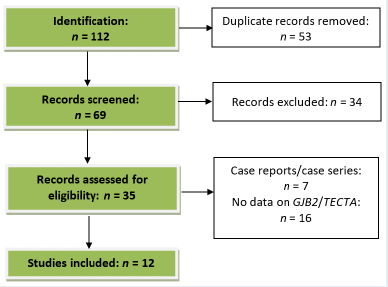Prevalence of TECTA and GJB2 mutations in Asian children with nonsyndromic hearing loss: A meta-analysis
DOI:
https://doi.org/10.15419/bmrat.v10i6.812Keywords:
Asia, GJB2, Hearing impairment, meta-analysis, mutation TECTAAbstract
Introduction: The most common sensory disorder, hearing loss, may result from genetic causes. Various inheritance patterns exist, such as X-linked, autosomal dominant, autosomal recessive, and mitochondrial. However, the genetic underpinnings of racial distinctiveness and regional variation were incompletely understood. To fully evaluate the ethnic specificity of gap junction protein beta 2 (GJB2) and tectorin alpha (TECTA) mutations in this region, data from all GJB2 and TECTA gene studies on Asian children with hearing impairment were pooled and used in this research.
Methods: All nonsyndromic hearing loss studies on the prevalence of GJB2 or TECTA mutations published between 1990 and 2022 were retrieved from the PubMed database, evaluated for risk of bias, and meta-analyzed.
Results: Twelve studies were chosen, representing twelve prevalence estimates. The prevalence of GJB2 and TECTA mutations in Asian patients with nonsyndromic hearing loss was 13.36% (95% confidence interval [CI]: 7.74%?20.14%), varying significantly among trials (I2 = 96.74%; P < 0.001). The pooled prevalence of TECTA and GJB2 mutations was 3.6% (95% CI: 1.9%? 5.7%) and 24.06% (95% CI: 11.43%?31.35%), respectively.
Conclusions: There was an association between TECTA/GJB2 mutations and hearing impairment, but there were also regional and ethnic differences in mutation prevalence. Studies with larger sample sizes and genetic analyses based on long-read sequencing are needed to understand the mutations resulting in hearing loss.

Published
Issue
Section
License
Copyright The Author(s) 2017. This article is published with open access by BioMedPress. This article is distributed under the terms of the Creative Commons Attribution License (CC-BY 4.0) which permits any use, distribution, and reproduction in any medium, provided the original author(s) and the source are credited.
